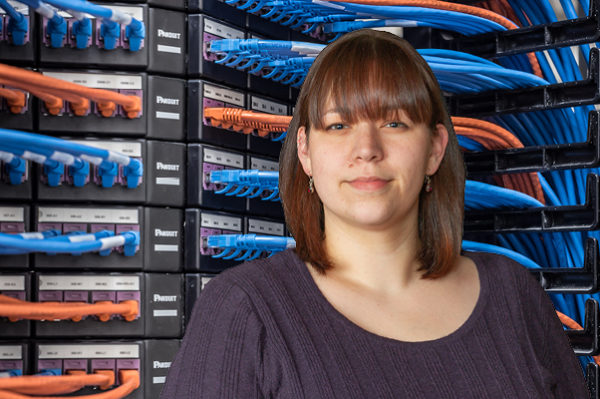For network engineer Kalina Dunn, never taking the easy way out leads to success.
Guest post by: Alisa Alering, Science Node
First published on Science Node on 17th October 2018

Courtesy Emily Sterneman.
For Kalina Dunn, it’s all about the puzzles. As a network engineer at Indiana University’s GlobalNOC, Dunn thrives on solving problems.

Winning conversation. Kalina Dunn (r), network engineer for Indiana University’s GlobalNOC, chats with Science Node editor Alisa Alering (l) about puzzles, problems, and traveling to SC18 to help build the world’s fastest temporary computer network. Courtesy Alicia Hosey.
“Network engineers are like the plumbers of the network,” Dunn says. “If a pipe gets too congested, it’s our job to troubleshoot and ensure that everything moves quickly and efficiently so that everyone who uses the network is happy.”
In her case, that’s a lot of people to keep happy, since Dunn is responsible for operations on three regional research and education networks, PennREN, Southern Crossroads SoX, and Rhode Island’s OSHEAN.
All of these networks are set up differently, using different protocols and equipment. But that doesn’t bother Dunn. “I love to solve these puzzles,” she says. “I really get into researching, digging around, and talking to different communities to maintain network health and solve problems when they come up.”
And now she has a new puzzle to figure out – Dunn is going to help build SCinet, the dedicated high-capacity network for SC18, the world’s biggest supercomputing conference.
Building from the ground up
Dunn is one of just five women to be selected for this year’s Women in IT Networking at SC (WINS) program at SC18, taking place in Dallas, TX, November 11-16.

Practical experience. The WINS initiative addresses the gender gap in IT by funding women for hands-on network-building experience and mentoring at the world’s biggest supercomputing conference, SC18. Courtesy SC17.
Established in 2016, the National Science Foundation (NSF)-funded WINS initiative is a practical means for addressing the large gender gap that exists in IT, particularly in network engineering and high-performance computing (HPC).
Each year, five early-to-mid-career women are selected to participate in building SCinet, the network infrastructure on which the entire SC conference depends. As well as providing the 12,000+ attendees with a high-speed wireless connection, the volunteer-built network supports the revolutionary applications and computing experiments demonstrated on the show floor.
This year’s WINS awardees will travel to Dallas for a week in October for hands-on set-up of the 3.6 Terabit network: staging, installing, building. They then return to the conference site for two weeks in November to set up and run the network during the show itself.
This will be Dunn’s first visit to a supercomputing conference, and she is especially excited about the chance to participate in building a network from the ground up.
“I maintain networks every day, but I’ve never actually been a part of the design, and the struggles that you go through– and then there’s the accomplishment of getting it working,” Dunn says. “And of course, SCinet is one of the fastest and most powerful networks in the world. Being a part of that will be an amazing experience.”
Networking in more ways than one

Networking of the human kind is one of the biggest benefits of the WINS initiative. Participants have the opportunity to meet and learn from the best in the field and form relationships that may persist throughout their careers. Courtesy SC17.
Though Dunn is looking forward to getting her hands dirty unspooling cable and racking equipment, she already suspects that the most valuable part of the WINS experience won’t be the technology, but the people.
Each WINS participant is paired with a mentor on the SCinet team and will have the opportunity to meet and learn from some of the best in the field. Dunn has already benefited from the support of her colleagues and managers at GlobalNOC.
“My current mentor never lets me take the easy way out of anything,” says Dunn. “While that makes life harder sometimes, it has really made me grow as an engineer.”
And it was her manager, Caroline Weilhamer, who initially alerted her to the WINS program and encouraged her to apply.
“All of my mentors have been incredibly supportive,” Dunn says. “Whenever I would feel down about not getting something, they’d continue to push me, while at the same time making sure I had all the resources I needed to figure it out and move forward.”
Dunn says that despite being a woman in a largely male-dominated field, she has experienced few hurdles related to her gender. But she does emphasize that it’s incredibly helpful to have female role models to look up to.
“Both my manager and my director are very strong IT women,” Dunn says. “I hope that I can be that equivalent in the future.”
Networking in more ways than one
Though Dunn is looking forward to getting her hands dirty unspooling cable and racking equipment, she already suspects that the most valuable part of the WINS experience won’t be the technology, but the people.
About the author: Alisa Alering, Managing Editor, Science Node
[one_third valign=”top” animation=”none”]

[/one_third]
[two_third_last valign=”top” animation=”none”]
Originally trained as a librarian, Alisa loves tracking down the science behind her stories and learning something new about technology every day. With previous experience as a freelance writer and photo editor, she has held positions at Indiana University Press, PBS, and Google and earned degrees from Penn State and Indiana University. She particularly enjoys writing about women and diversity in technology, digital humanities, and the intersection of science and the natural world.
[/two_third_last]
About Science Node
[one_third valign=”top” animation=”none”]

[/one_third]
[two_third_last valign=”top” animation=”none”]
Science Node is an online magazine that connects the global research community, exploring how tech works and showing why it matters to our everyday lives. sciencenode.org
[/two_third_last]

